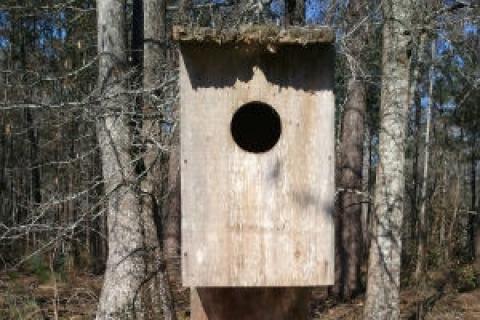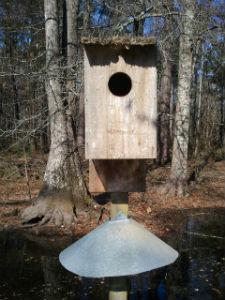
 Especially in the southeastern states, the wood duck plays an important role as one of the top ducks in the hunter's bag. The federal limit per day per hunter for wood ducks was raised from two woodies to a three wood duck limit just a few years ago due to a sustainable harvest. Hunters need to play a role in spring by maintaining wood duck boxes to aid in their reproduction.
Especially in the southeastern states, the wood duck plays an important role as one of the top ducks in the hunter's bag. The federal limit per day per hunter for wood ducks was raised from two woodies to a three wood duck limit just a few years ago due to a sustainable harvest. Hunters need to play a role in spring by maintaining wood duck boxes to aid in their reproduction.
Unlike most other species of ducks, the wood duck can adapt to nest in a man made duck box. True to their name, wood ducks haunt the woodlands and are also adept at nesting in tree cavities and other hideaways. Among the earliest ducks to begin nesting, wood ducks are usually paired up by the end of February and looking for a suitable nesting site.
Wood ducks can be picky though, especially as it concerns previously used wood duck boxes. If egg shells and moldy bedding materials are present in early spring, they may shun that box. Wildlife managers must be willing to visit and service their boxes each and every year. This gives the outdoor enthusiast a great reason to be outside, and provides an opportunity to encounter wildlife.
Opening a wood duck box in order to empty the contents and provide fresh bedding sounds like an easy chore, but there is a lot of adventure along the way. First, consider that the wildlife manager is likely up on a step ladder and perched over some kind of water. The wood ducks long since moved out of the nest box after their ducklings hatched last spring, but what if anything might have moved in?
Encounters with screech owls are not uncommon when opening the top of the nest box, nor is a large pile of pinstraw brought in by another woodland songbird that thought the duck sized box was a good fit for them too. A metal predator guard underneath the box usually keeps the ground critters away, but snakes can be inside the box since they can sometimes drop down from an overhanging branch.
When it comes to insects don't forget about wasps, since they love the protection afforded by a nesting box. A can of wasp spray is always prudent to have handy, and works well on spiders too. And if the nest box post is in dry dirt, like perhaps on a ***, there is a good chance that ants are using the box and some ant bait will need to be applied at the base.
After opening the box and dealing with any visitors, use a pair of leather gloves to scoop out any old bedding material, egg shells, spider webs and residue. Then add fresh pine shavings to cover the entire bottom of the nest box, and fasten the lid shut. The hen woodie will add her own down feathers to the bedding, and she generally will have a dozen or so eggs to incubate. The opening on the front of the box is a great place to train your game camera to watch for nesting activities and ducklings.
- 5279 views

